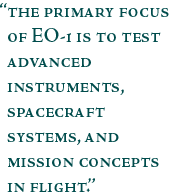

| |||
At the beginning of the new millennium, NASA has an ambitious vision for its space program: to accelerate space exploration through the development of highly advanced technology. Enter NASA's New Millennium Program (NMP), an advanced-technology development program created to infuse a new generation of technologies and mission concepts into future Earth and space science missions.
The program is unique in that it tests its advanced technologies in space flight. Though many space-related technologies can be tested sufficiently in laboratories on Earth, the technologies and concepts NMP selects—such as solar electric (ion) propulsion or spacecraft flying in formation—present a fairly high risk to missions that will use them for the first time. A full test in orbit is needed before these risky technologies are built in to an operational system. Flight testing in space is also important for some technologies because spacecraft may encounter environments or situations that cannot be replicated on the ground such as zero gravity, or high levels of radiation exposure or solar wind. The value of the NMP missions is to lower the risk for future missions that use these technologies to carry out challenging scientific exploration. Every few years starting in November 2000, NMP will send a mission into deep space or into low Earth orbit to test new suites of technologies. On November 21, 2000, NASA launched the first NMP mission, Earth Observing-1 (EO-1), on a Delta 7320 rocket from Vandenberg Air Force Base, California. Flying at an altitude of 705-kilometers, EO-1 will orbit in a circle around the Earth very nearly from pole to pole and descend across the equator at about 10:02 am local time (referred to as a "sun-synchronous" orbit). While the primary focus of the EO-1 mission is to test advanced instruments, spacecraft systems, and mission concepts in flight, EO-1 will also return scientific data as a by-product of its testing. At least once or twice a day, both Landsat 7 and EO-1 will image the same ground areas. All three of the EO-1 land-imaging instruments will view all or segments of the Landsat 7 swath and scientists will be able to compare these "paired scene" images. By comparing scenes from each of the spacecraft, scientists will be able to recommend improvements to future instruments and spacecraft and ensure the continuity of land-imaging data in the future. next: The Earth-Sensing Legacy
|
by Steve Graham  Earth Observing-1
Related EO-1 Links
| ||